Ini adalah 3 tehnik flourish simple mengatur posisi kartu atas dan bawah tetap pada tempatnya
Next - Simple Flourish (Noir, Little Genesis, Neutrino)
31 Mei 2010
30 Mei 2010
Short For Sorcery
By Richard Robinson
The magician shuffles the deck, or someone else can. He riffles the ends of the cards, asking a spectator to tell him when to stop. At that point he cuts away the top cards and extends the rest of the cards towards the spectator, asking that the selected card be taken, looked at and returned. A quick shuffle, then the magician declares the card gone, existing only in the spectator's imagination. He riffles slowly through the deck. The spectator does not see his card.

The magician informs the spectator the card was never in the deck to start with. He says the reason he knows that is because it is in the card box. The spectator opens the card box and discovers a single card inside, the one he selected.
Short For Sorcery is based on an effect briefly described by U.F. Grant and essentially uses the Svengali deck principle without needing a Svengali deck. Despite the method being reliable, it requires the proper handling, especially when slowly riffling the cards to show the selected one is missing. This takes some practice to ensure the cards are riffled slowly so that every card in the deck is briefly seen.
Setup
A deck of cards, one of which has been trimmed down at one narrow end to make a short card. A duplicate of this card which is left in the card box.
Handling

The right hand holds the narrow ends with fingers and thumb, pulls up on the cards and lets them escape slowly as the spectator is asked to say 'Stop.'
Lift off the cards above the short card and extend the left hand, asking the spectator to take the card he stopped at.

Above left: side view: Slowly riffle through the cards. The short card will not be seen.
Above right: spectator's view: Each card is momentarily visible, but the selected card is not among them.
Performance
Shuffle the cards, then cut the deck at the short card and complete the cut. This puts the short card somewhere near the center of the deck.
Hold the deck in the left hand, backs up in dealing position. The right hand moves over, takes hold of the narrow ends with fingers and thumb, pulls up on the cards and lets them escape slowly as the spectator is asked to say 'Stop.'
When the spectator indicates enough is enough, lift off the cards above the short card and extend the left hand, asking the spectator to take the card he stopped at, look at it, and return it to the deck.
Replace the top stock, shuffle the cards and again cut the short card to the center of the deck.
Take the ends of the deck in the right hand, turn the deck face up and with the left hand providing some support, slowly riffle through the cards. The short card will not be seen, and the spectator will admit that his card is no longer in the deck.
Ask the spectator to pick up the card box and look inside where he will discover his selected card. This provides enough activity to palm off the short card. Or it can remain in the deck for further use.
20 Mei 2010
Mengetahui Nomor PIN Orang Lain
Trik ini disubmit oleh Mifta Nurdin, peserta Yanamagic Competition I April 2010
Efek : dapat mengetahui nomor PIN ATM seseorang melalui perhitungan mathmagic.
Alat :
1. Kalkulator2. Selembar kertas
Prosedur :
1. Panggil satu orang penonton yang memiliki kartu ATM ke atas panggung.2. Katakan bahwa Anda mampu mengetahui nomor PIN seseorang dengan perhitungan math magic tetapi hanya 50 % saja tingkat keberhasilannya (hal ini dikatakan agar penonton mau bermain dengan Anda.
3. Berikan kalkulator kepada penonton tersebut).
4.a. Suruh penonton untuk memasukkan digit pertama nomor PINnya pada kalkulator kemudian dikalikan dengan 2, ditambah 5, dikali 5, lalu ditambah dengan digit kedua nomor PINnya, dikali 10, kemudian ditambah dengan digit ketiga nomor PINnya, dikurangi 139, dikali 12, dibagi 3, dikali 2,5, ditambah dengan digit keempat (digit terakhir) nomor PINnya, ditambah 1, dikali 4, dikali 12,5, dan yang terakhir tambahkan dengan usia penonton tersebut (sebelumnya, suruh penonton menuliskan dulu 4 digit nomor PINnya pada selembar kertas agar penonton tidak berbohong). Suruh penonton untuk mengatakan hasil akhirnya, pasti ada 6 digit angka.
4.b. Untuk mengetahui nomor PINnya, kurangi hasilnya dengan 111100. Empat digit pertama adalah nomor PINnya. Dua digit angka terakhir adalah usia penonton. Jangan hiraukan itu. Hal tersebut hanya untuk memanipulasi pikiran penonton.
5. Setelah Anda mengatakan nomor PIN penonton tersebut, katakan bahwa dia harus segera mengganti nomor PINnya.
Uji kebenaran trik :
misal : nomor PIN penonton adalah 1234 dan usia penonton adalah 36.
(1 x 2 + 5) x 5 = 35
(35 + 2) x 10 + 3 - 139 = 234
(234 x 12 : 3 x 2,5) + 4 = 2344
(2344 + 1) x 4 x 12,5 x 2 + 36 = 23436
23456 - 111100 = 123436 --> 4 digit pertama adalah nomor PIN penonton.
Amanat : Jangan ceritakan sesuatu yang menjadi rahasia bagi diri Anda kepada orang yang baru Anda kenal.
Nama : Mifta Nurdin
TTL : Tegal, 22 Januari 1994
Alamat : Margasari, Tegal
Sekolah : SMA N 1 Balapulang
Blog : miftamagic.blogspot.com
Aliran : mentalist, mathmagic
Title : The Prince of Number
Half and Half Trick
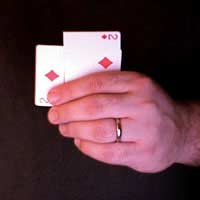
Like most mentalist tricks, the Half and Half trick gives the audience a false choice before revealing that the magician is a master of mind reading.
The Effect
The magician holds aloft a large sheet of cardboard. Along either side five cards are held in place with an elastic band, backs to the audience. At the top is a clip. The magician declares he will read the mind of a spectator and asks that one step forward. The magician takes a marker and writes on the side of the card board closest to him - “My prediction” he says. At this point he asks the spectator to point to one of the ten cards. The magician takes the card and places it under the clip on his side of the board and then turns it to show that the card chosen matches his prediction written large and bold before hand.
The Secret
The false choice created by making ten special cards in advance is the secret here.
Materials
Ten special cards are made (instructions below) and either a large clipboard with a notepad or a sheet of cardboard and a clip. Elastic bands and a marker round out the materials.
Preparation
The magician creates the special Half and Half cards and then places them in the bands. The notepad should be attached to the clip and the marker placed nearby.
This trick is more effective with a sheet of cardboard and a clip, but using a large clipboard with paper allows for reusing it for the next show. There are two parts to this trick - creating the cards and then performing Half and Half.
Creating the Cards
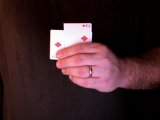 This trick requires ten identical cards and ten indifferent cards – the magician should make sure that one of the indifferent cards is not the same as the ten identical cards. Each of the indifferent cards should be cut across the width; about a third of the card is required. Each indifferent third is then glued atop one of the ten “force cards”, so called because the magician is forcing the spectator to chose this card unbeknownst to him.
This trick requires ten identical cards and ten indifferent cards – the magician should make sure that one of the indifferent cards is not the same as the ten identical cards. Each of the indifferent cards should be cut across the width; about a third of the card is required. Each indifferent third is then glued atop one of the ten “force cards”, so called because the magician is forcing the spectator to chose this card unbeknownst to him. 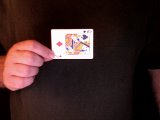 When done the card should be two thirds force card and one third indifferent card.
When done the card should be two thirds force card and one third indifferent card. Performing the Trick
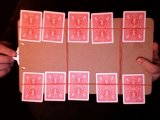 The ten cards are placed under the elastic on the back of the cardboard sheet. From the magician’s point of view only the indifferent end should be visible.
The ten cards are placed under the elastic on the back of the cardboard sheet. From the magician’s point of view only the indifferent end should be visible. 
- The magician chooses a spectator and then declares he will look into the future and make a predication about which of the ten cards the spectator will chose. The magician then writes the force card on the cardboard sheet, out of view of the spectator.
-
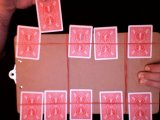 The magician allows the spectator a free choice, but not to touch the cards. After the choice is made, the magician allows the spectator one chance to change his mind and make a new choice.
The magician allows the spectator a free choice, but not to touch the cards. After the choice is made, the magician allows the spectator one chance to change his mind and make a new choice. 
- Once the choice is made, the magician takes the card (back facing the spectator) and clips it under the clip at the top of the cardboard. The indifferent end is hidden under the clip, and only the force end is visible.
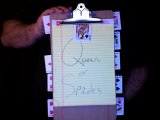 The magician then turns the board around to show that his prediction did, indeed, come true.
The magician then turns the board around to show that his prediction did, indeed, come true. 
Magical Tip
Do not make the clipping of the chosen card into a performance - the more natural and quickly you can do it, the more believable this trick is.Colour Changed
By Richard Robinson
Changing the color of a playing card by passing a hand over the face of the card was once a staple effect among conjurers. This dates from the time when cards had no corner index to disrupt the visual change of color. Although color changes have gone out of fashion, the various sleights used to accomplish them have not, since the sleights involved secretly add a card to the top of the deck. One particular color change sleight is encountered in most introductory magic books. The deck is held, faces out, in the left hand. The closed right hand covers the deck and when it moves away the face card has changed. This is accomplished by the left index finger sliding the bottom card of the deck up, the right hand palming it and then depositing it on the face of the deck.
While this sleight is reasonably effective, it isn't that difficult for the spectators to figure out, since the right hand curls and uncurls as the card is palmed and then released.
Chris Van Bern's Colour Change
By all indications Chris Van Bern is the inventor of the original sleight on which the description above is based. However, Van Bern's method was significantly different in that the card was never actually palmed and thus the hand remained in the same position throughout the illusion.
Van Bern first published his Colour Change in the 1914 edition of the 'Wizard's Annual' and then again in 1919 in 'A Whirlwind of Wizardry' which he co-authored with De Vega, another performer of the period. It is interesting to note that by 1919 Van Bern was no longer using the move as a color change but rather to make selected cards appear on the face of the deck.
Handling

The deck is held in the left hand, one long side of the deck resting on the fingers, the other held by the thumb.
The right open right hand, with fingers together is brought over to cover the face of the deck.

As this happens, the left first finger pushes the back card of the deck up and then into the right palm. The left index finger remains extended, holding the card against the right palm. The right hand does not palm the card.

The the card makes contact with the right palm, the left hand turns at the wrist, pivoting around the left first finger tip, until the face of the deck is visible below the right hand. This is done to give the spectator's one more look at the face card. The extended left first finger is masked by the right hand and the deck during this movement.

The left hand then turns back, pivoting around the left first finger tip, until the deck is behind the right hand.

In swinging the deck back behind the hand, the left first finger is pulled away and the deck itself is used to hold the card against the right palm. The deck is turned and squared up so that the card behind the right palm is now the face card of the deck. The right hand moves away from the deck, the right fingers spreading.

As right hand moves away the face card of the deck is seen to have changed.
Display Variation

Once the card has been moved from the back of the deck into the right palm, the left first finger can slide the card back towards the right wrist. This allows the right fingers to open as the deck is swung down and the original face card shown.
Performance Notes
Once you've got the general idea of this and curbed the natural magical instinct to curl the right hand into palm position, the deceptiveness of this sleight will be apparent.
The deck can be swung up above the hand rather than below it, during the show once more move.
It is also possible for the card being held to be positioned toward the back of the right hand in more of a gambler's palm location as shown in the variation above. This allows the right fingers to spread slightly during the moves.
Van Bern suggested that the fingers of the right hand be held wide apart as the hand is placed in position so that the face card could be seen through them, then closed before the change.
4 Mei 2010
Ball & Silk Mistery
By Richard Robinson The magician picks up a silk handkerchief from his table and opens the handkerchief out to display both sides at his finger tips. The handkerchief is draped over his left hand. Slowly and mysterious a large red ball rises up out of the center of the handkerchief.  The ball is wrapped in the handkerchief, the handkerchief is tossed into the air and the ball vanishes ... as if it had never existed to start with. Props A ball approximately 1-3/4 inches / 45 mm in diameter as used in the Multiplying Billiard Balls and other stage manipulations. A ball made of wood or hard plastic is recommended. An 18 inch / 33 cm square handkerchief. The ball and handkerchief should be of contrasting colors. The silk handkerchiefs sold by magic dealers is ideal, although any cloth square of light weight and good drape will do. Setup The bunched handkerchief is on the table with the ball behind it. Handling | ||||||||||||||||||||||||||||||||||||||||||||||||
| ||||||||||||||||||||||||||||||||||||||||||||||||
| Routine Phase 1 The left hand reaches over and picks up the handkerchief, at the same time taking hold of the ball so that it is held loosely in the palm of the hand. This hold is similar to the classic palm without any pressure being exerted on the ball. Facing the spectators, the left and right hands come together in front of the upper chest and to the right of the center of the body. The left and right fingers unfold the handkerchief until one corner can be clipped between the left first and second fingers. The right fingers then slide along the edge of the handkerchief, moving to the right at the same time, until they hold the adjacent corner. This opens the handkerchief out so that it is being displayed between the hands. As the handkerchief is opened out, the magician turns his shoulders slightly to the right. The left hand moves back to the chest and presses the ball between the palm of the hand and the chest. The left fingers open out and the left hand is moved toward the right. The ball, trapped between the palm and the chest, rolls along the back of the palm. This movement stops when the ball is positioned between the heel of the left and and the chest. With the ball out of view, the left fingers can be spread apart. The right fingers also open out. The magician looking toward the right hand, gives the handkerchief a slight shake. Phase 2 The left hand moves back so that the ball rolls into the palm of the hand where it is classic palmed. The right hand follows the left hand's movement. The front of the handkerchief is kept parallel to the spectators. With the ball in a classic palm, the left and right hands continue moving to the left until both arms are extended. The magician's shoulders turn left and tension is maintained by the hands to keep the handkerchief open taut between the hands. Although the left palm is now toward the spectators, the left fingers are curled over it and the edge of the handkerchief covers them, hiding the ball. The left hand releases its hold on the handkerchief and moves down behind the handkerchief to its center and then starts moving up. The right hand lets go of the handkerchief. The handkerchief is now draped over the left hand. The top of the left hand should be at shoulder height, the left arm half extended to the left of the body. Phase 3 The right fingers pretend to adjust the corners of the handkerchief hanging down around the left hand. As the this is done, the left arm swings to the right until the handkerchief draped left hand is at the center of the chest. The right fingers have moved as well, getting a light hold on the hem of the handkerchief closest to the magician and working their way under the handkerchief until the right hand is under the draped handkerchief. The left hand releases its hold on the ball, dropping it into the right hand which classic palms it. The right hand moves back down to take hold of the handkerchief hem. The left arm swings to the left, the right hand moving with it so that the back of the right hand remains toward the spectators. The left hand then swings back to the right, the right hand moving up until it is directly behind the left hand. During this movement, the left hand opens out so that it comes to rest on the back of the right hand, almost cupping it. The right hand, now hidden from the spectators, turns palm toward the left hand so that the ball rests on the handkerchief and through it on the left palm. The right fingers open out and point up, then curl down over the left thumb, as it pushing the center of the handkerchief down into the left fist. In fact the right fist and second fingers have arched over the left thumb and moved down to contact the top of the ball through the handkerchief. The right thumb is pressing against the bottom of the ball. Once the right fingers and thumb are supporting the ball, the handkerchief covered left thumb swings around the left of the ball and behind it, pressing the ball through the handkerchief against the left palm. The right hand moves away. The ball is now below the top of the handkerchief covered left fist, held in place through the handkerchief by the left thumb, and not at all visible to the audience. Phase 4 The left hand moves up to eye height, extended a foot or so in front of the magician's face. The left hand stops. The left fingers and thumb now slowly work the ball up until it is resting on top of the left fist. The ball appears to rise up out of the handkerchief. Once the ball is visible, the right fingers take hold of a corner of the handkerchief and move up. The left hand lowers a few inches. The left hand opens palm up under the handkerchief. The right hand pulls the handkerchief slowly back and up. This causes the ball to roll down the handkerchief and come to rest in the open left palm as the handkerchief is pulled away. Vanish The ball rests on the open left palm. The right hand holds the handkerchief. The right hand moves to the left hand so that one corner of the handkerchief can be clipped between the left first and second fingers. The right hand then moves right to open out the handkerchief so that it can be displayed front and back. In one continuous motion, the right hand releases its hold on the handkerchief, the hand opens and swings toward the front center of the handkerchief. The left hand releases its hold on the handkerchief. The result is that the handkerchief is now draped over the right hand, the hand itself being palm up under the handkerchief. The left hand moves to the right, back of the hand turned toward the audience and appears to drop the ball onto the handkerchief covered right palm. The right fingers curl up as it holding the ball through the handkerchief. In fact, the ball is simply classic palmed in the left hand. The right hand turns over and grasps the supposed ball through the handkerchief. With practice this can be done so that the handkerchief bunches enough at the center to momentarily look as if the ball is inside the handkerchief. The handkerchief is tossed into the air and caught by the right hand. The ball has vanished. The right hand shakes out the handkerchief. Then the right and left hands take hold of the top corners and show the handkerchief back and front, using the moves described in the production phase to keep the palmed ball hidden. The right hand bunches up the handkerchief and places it on top of the ball in the left hand as the left hand opens. The right thumb presses the ball against the back of the bunched handkerchief and raises both slightly so the open left hand can be titled toward the audience. The right hand uses the bunched handkerchief to dust off the left fingers. The left hand takes hold of the bunched handkerchief and ball and sets them down on the table, ball to the back. Performance Notes The moves used here are easy to master, most of the manipulation being hidden by either the handkerchief or body position. | ||||||||||||||||||||||||||||||||||||||||||||||||
Langganan:
Komentar (Atom)
Welcome To Yanaward
Visitor
Kinds of Magic
Avatar Magic
(7)
Balls Tricks
(4)
Clairvoryant
(1)
Classic Magic
(4)
Close-up
(9)
Coin Trick
(13)
Escapetology
(3)
Fakirs
(5)
Hipnotist
(2)
Illusionis
(35)
Kartu
(32)
Levitation
(3)
Mathemagics
(38)
Mentalis
(51)
Mind Reading
(1)
Pengetahuan Umum
(19)
Quiz
(2)
Stage
(13)
Street Magic
(15)
Telepati
(1)
XCM
(5)










